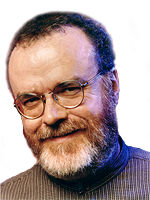Don't Get Me Started: Return to Pleasantville
 We live in troubling times. Many people look at our society and see an increasing erosion of morality and civility, which leads them to yearn for the perfect suburbia as depicted in early television sitcoms such as Father Knows Best and Leave It to Beaver.
We live in troubling times. Many people look at our society and see an increasing erosion of morality and civility, which leads them to yearn for the perfect suburbia as depicted in early television sitcoms such as Father Knows Best and Leave It to Beaver.
This yearning is beautifully addressed in the movie Pleasantville from New Line Cinema, which I recently revisited on DVD. Written, produced, and directed by Gary Ross, this film starts in late-1990s America, where nerdy David (played by Tobey Maguire) and his slutty twin sister Jennifer (Reese Witherspoon) are high-school students with a single mom who cares less about her kids than a weekend getaway with her latest stud.
Jennifer smokes and sleeps around while David escapes by watching reruns of a '50s sitcom called Pleasantville on the TV Time cable channel (a clear nod to TV Land). As a marathon of episodes begins, Jennifer fights for the remote control because she invited her new boyfriend over to watch the latest MTV concert.
The remote breaks during their struggle, and a mysterious TV repairman (Don Knotts) appears at the door and gives them a new one "with more oomph." The device promptly transports them into the black-and-white world of Pleasantville. David becomes Bud Parker, son of George (William H. Macy) and Betty (Joan Allen), and Jennifer becomes their daughter Mary Sue, completing the quintessential '50s family at the center of the sitcom.
At first, David/Bud is ecstatic in his new environment, which he already knows intimately, but Jennifer/Mary Sue is miserable. She quickly seduces the school's basketball captain, introducing him to the pleasures of the flesh at Lover's Lane, which had previously been used for nothing more than holding hands. This sets off a chain of events that changes Pleasantville forever. As the residents begin to have "real" creative and emotional experiences, their world gradually turns from black and white to color.
One of the things I like best about this movie is its ambivalence toward the lifestyle portrayed by '50s sitcoms. As the town and its inhabitants are colorized, something is gained, but something is lost. On the plus side, the Pleasantvillagers gain the freedom to be who they want to be instead of following their predefined, conformist roles. They also gain a sense of joy and passion; like the sitcoms on which Pleasantville is modeled, husbands and wives sleep in separate beds. In fact, no one knows what sex is before David and Jennifer arrive.
Perhaps even more important, they gain knowledge. Mary Sue discovers that the pages of the books in the library are blank; only their covers are complete (a wonderful metaphor for the townspeople themselves). As she and Bud relate the contents of the books to their friends, the pages magically fill in, and all the kids soon flock to the library to read about the rest of the world.
However, Pleasantville seems to lose as much as it gains in this transformation. For one thing, the town is no longer safe and secure. Before David and Jennifer arrive, nothing burns; the fire department's only job is rescuing cats stuck in trees. But when Mrs. Parker explores her erogenous zones in the bathtub (at her daughter's suggestion), a tree in the front yard spontaneously bursts into full-color flame, and the firemen don't know what to do about it.
Another problem appears on the flip side of passion: promiscuity and adultery. Once Mrs. Parker is awakened to her sexual nature (which she cannot share with her husband), she kindles a romance with Mr. Johnson (Jeff Daniels), the artistic soda jerk who then paints her nude portrait in color on his malt shop's window. This enflames the remaining black-and-white citizens, who become an angry mob, trashing the shop and assaulting Mrs. Parker. Clearly, change breeds fear and violent hatred as easily as it brings liberation.
The film is filled with excellent touches that reinforce the story and relate it to the real world. As the transformation unfolds, the background music slowly evolves from the innocence of "Be-Bop-A-Lula" by Gene Vincent to more subversive, modern forms; Dave Brubeck's "Take 5" is particularly effective in this regard. Holdout black-and-white shopkeepers put signs reading "No Coloreds" in their windows, linking their overt fear of change to the racism that '50s television tried to ignore.
Pleasantville makes a powerful statement about appearance and substance, freedom and responsibility, television and society. The safe, secure '50s television world that David sought turned out to be a joyless façade, pale in comparison with the passion and expressive potential of the '90s world he wished to escape.
But freedom has its price: a society in which violence and hatred can flourish. In addition, TV viewers must risk being offended by programming that is far from pleasant. The movie's most obvious metaphor—eating an apple—reminds us that one taste of knowledge inevitably alters paradise. Is it worth it? Pleasantville offers no black-and-white answers but plenty of food for thought.
- Log in or register to post comments



































































